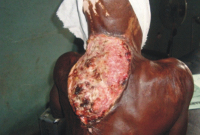Marjolin's Ulcers in South Eastern Nigeria - A15 Year Review at the Close of the last Millennium
DOI:
https://doi.org/10.60787/tnhj.v15i2.216Keywords:
Marjolin's ulcer Pattern, Management Challenges, South Eastern Nigeria, Millennium ReviewAbstract
Background: Marjolin's ulcers first reported by Celsius more than 2000years ago still have a poor prognosis with poorly understood evolution. Thought to be rare, it has been reported to be commoner in sub-Saharan Africa including southern Nigeria^ with a more aggressive natural history. Thus an attempt is made to review the pattern of presentation of marjolin's ulcers, and challenges of management in South Eastern Nigeria as at the close of the last millennium.
Method: Case records of patients managed for marjolin's ulcers at the National Orthopaedic Hospital, Enugu, Nigeria from January 1980 to December 1994 were reviewed. The data obtained were analyzed using descriptive statistics.
Results: Seventy (70) patients were managed for marjolin's ulcers in the period under review, constituting 27%of primary skin cancers managed in that period. The mean age of the patients was 44.9 years with a male: female ratio of 2:1
Thirty seven (53%) arose from an active chronic ulcer while 33(47%) originated from previous scars with an average interval of onset of22.1yrs. The post-burn scars had a shorter interval of onset of 11.6yrs, compared to 29.8 yrs for the non- burn scars.
The lower limbs were most commonly involved (71%), while the trunk was least involved (3%). Squamous cell carcinoma was the histologic type in 66 (95%) patients.
Fifty two (74%) patients commenced treatment with amputation being the commonest form of treatment offered. Follow up was poor as only 3% had follow up for up to 5 years or until death.
Conclusion: This study has shown that about 50% of Marjolin's ulcers arose from unstable scars and were therefore potentially preventable. Improved access to appropriate healthcare as captured in the millennium development goals should reduce the incidence and improve outcome.
Downloads

Downloads
Published
How to Cite
Issue
Section
License
Copyright (c) 2016 The Nigerian Health Journal

This work is licensed under a Creative Commons Attribution-NonCommercial-NoDerivatives 4.0 International License.
The Journal is owned, published and copyrighted by the Nigerian Medical Association, River state Branch. The copyright of papers published are vested in the journal and the publisher. In line with our open access policy and the Creative Commons Attribution License policy authors are allowed to share their work with an acknowledgement of the work's authorship and initial publication in this journal.
This is an open access journal which means that all content is freely available without charge to the user or his/her institution. Users are allowed to read, download, copy, distribute, print, search, or link to the full texts of the articles in this journal without asking prior permission from the publisher or the author.
The use of general descriptive names, trade names, trademarks, and so forth in this publication, even if not specifically identified, does not imply that these names are not protected by the relevant laws and regulations. While the advice and information in this journal are believed to be true and accurate on the date of its going to press, neither the authors, the editors, nor the publisher can accept any legal responsibility for any errors or omissions that may be made. The publisher makes no warranty, express or implied, with respect to the material contained herein.
TNHJ also supports open access archiving of articles published in the journal after three months of publication. Authors are permitted and encouraged to post their work online (e.g, in institutional repositories or on their website) within the stated period, as it can lead to productive exchanges, as well as earlier and greater citation of published work (See The Effect of Open Access). All requests for permission for open access archiving outside this period should be sent to the editor via email to editor@tnhjph.com.









